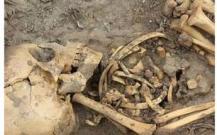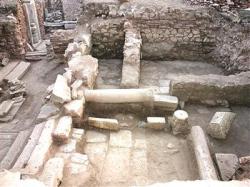INSTITUT SUPERIEUR D'ANTHROPOLOGIE
INSTITUTE OF ANTHROPOLOGY
ONLINE COURSES / COURS A DISTANCE
NEW OPEN COURSE : JANUARY 2013
HRM 104 : INTRODUCTION TO INTANGIBLE CULTURAL HERITAGE
REGISTER NOW
BELGIQUE –  Dinant - Les ouvriers qui travaillent rue Saint-Martin, à Dinant, ont fait hier une découverte étonnante voir même macabre: six tombes et plusieurs squelettes datant du 4e siècle. Les coups de pioche des ouvriers ont mis à jour hier ce qui semble être l’ancien cimetière paroissial de l’église Saint-Martin, situé sur le site même d’un chantier d’égouttage tout ce qu’il y a de plus normal. Les tombes et squelettes ont été découverts à plus de 8 mètres de profondeur. "Tout cela faisait partie du cimetière paroissial de l'église Saint-Martin", a affirmé le bourgmestre. "L'époque du 4e siècle a pu être déterminée grâce aux analyses d'objets qui se trouvaient dans les tombes. D'autres sépultures qui étaient superposées sur les plus anciennes ont également été découvertes. Elles dateraient du 9 ou 10e siècle", selon Richard Fournaux. Les travaux d'égouttage ont été suspendus à cet endroit mais ont repris plus loin dans la rue afin de permettre aux archéologues de la Région Wallonne de continuer les fouilles. "Ils ont arrêté durant la nuit et ont repris très tôt ce matin. Impossible de dire pour l'instant s'ils ont découvert d'autres choses. Ils continueront les recherches tant qu'ils veulent, tant que ça n'a pas d'impact sur les travaux. Tout ce qui a été découvert devrait être emmené par les services de la Région Wallonne avant d'être sans-doute rapatrié à la maison du patrimoine mosan", a conclu Richard Fournaux.
Dinant - Les ouvriers qui travaillent rue Saint-Martin, à Dinant, ont fait hier une découverte étonnante voir même macabre: six tombes et plusieurs squelettes datant du 4e siècle. Les coups de pioche des ouvriers ont mis à jour hier ce qui semble être l’ancien cimetière paroissial de l’église Saint-Martin, situé sur le site même d’un chantier d’égouttage tout ce qu’il y a de plus normal. Les tombes et squelettes ont été découverts à plus de 8 mètres de profondeur. "Tout cela faisait partie du cimetière paroissial de l'église Saint-Martin", a affirmé le bourgmestre. "L'époque du 4e siècle a pu être déterminée grâce aux analyses d'objets qui se trouvaient dans les tombes. D'autres sépultures qui étaient superposées sur les plus anciennes ont également été découvertes. Elles dateraient du 9 ou 10e siècle", selon Richard Fournaux. Les travaux d'égouttage ont été suspendus à cet endroit mais ont repris plus loin dans la rue afin de permettre aux archéologues de la Région Wallonne de continuer les fouilles. "Ils ont arrêté durant la nuit et ont repris très tôt ce matin. Impossible de dire pour l'instant s'ils ont découvert d'autres choses. Ils continueront les recherches tant qu'ils veulent, tant que ça n'a pas d'impact sur les travaux. Tout ce qui a été découvert devrait être emmené par les services de la Région Wallonne avant d'être sans-doute rapatrié à la maison du patrimoine mosan", a conclu Richard Fournaux.
http://www.rtl.be/info/votreregion/namur/966086/dinant-decouverte-archeologique-sur-un-chantier
BULGARIE – Sofia - Archaeologists have found a basilica said to date from the time of emperor Constantine the Great in the area of the West Gate of Serdica, as the city was known in Roman times. The basilica is 27 metres wide and about 100m long, according to Yana Borissova-Katsarova, head of research at the site. It featured multi-coloured mosaics. Further exploration of the find will be difficult because of its location under the modern city. Sofia deputy mayor in charge of culture, Todor Chobanov, said that the discovery of the basilica may be proof that Constantine intended to establish the city as a centre of Christianity. Constantine, who ruled from 306 to 337 CE, was the first Roman emperor to convert to Christianity. Sofia, as Serdica, was under Roman rule from 29 BCE and remained under Roman and later Byzantine rule, with some interruptions because of Hun invasions and destruction, for a number of centuries. Serdica is said to have been described by Constantine as “my Rome”. Chobanov said that the discovery of the basilica suggested that this saying attributed to Constantine was “not just words”. The area around the West Gate of Sofia is being studied by archaeologists as part of a programme being funded mainly by Sofia municipality. Work at the site has resulted in the uncovering of the wall, a gate and tower. The gate was said to date from the fifth to sixth century CE, and the tower from the sixth. The wall was initially built in the second century by emperor Marcus Aurelius and was later expanded and strengthened. The foundations, two metres deep, suggest that the wall about eight to nine metres high. Excavations had found that Serdica had been a very well developed town in terms of irrigation and sanitation. Archaeologists had found pipelines for fresh water. Archaeologists had found the Via Militaris, the street used mainly for military purposes and leading to the city wall. Most of the artifacts found at the site were related to everyday life, such as coins.
http://sofiaglobe.com/2012/12/12/archaeology-basilica-from-the-time-of-constantine-the-great-found-at-sofias-serdica-west-gate/
TURQUIE –  Zeytinliada - The Mother Mary church, located in the modern of village of Zeytinliada near Erdek and known in ancient sources as “the greatest church in the world,” has been undergoing excavation since 2006 and will soon open to tourists as a new archeopark. The project began with the support of the Culture Ministry, Directorate of Archaeology and Museums and Erdek Municipality in 2006, said Öztürk. “During the excavation of the site called the East Church, it took three years to unearth the church itself,” Öztürk was quoted as saying in an earlier Anatolia news agency report. The team has been digging at the site of an adjacent monastery for the past three years. “The church was located in the monastery complex and also served as a baptistery church. Both belong to the early Byzantine era. The story of the construction of the church is very similar to that of the Hagia Sophia, dating back to 532-537 A.D.,” Öztürk said. “At that time, the local citizens rose up in protest against the high taxes imposed by the empire. The revolt had to be quashed, and at the direction of the emperor, the citizens were gathered in the hippodrome and 30,000 people were slaughtered and burned. The rebellion was suppressed, and it is known as the ‘Nika Rebellion.’ The empire wanted to create the world’s largest dome in memory of its victory over the rebellion, and that is how the Hagia Sophia came to be built,” he said. “Our work has progressed,” he said. “Restrooms, walkways and observation zones are under construction. A restoration project will be brought into action. This is an important place for religious tourism.”
Zeytinliada - The Mother Mary church, located in the modern of village of Zeytinliada near Erdek and known in ancient sources as “the greatest church in the world,” has been undergoing excavation since 2006 and will soon open to tourists as a new archeopark. The project began with the support of the Culture Ministry, Directorate of Archaeology and Museums and Erdek Municipality in 2006, said Öztürk. “During the excavation of the site called the East Church, it took three years to unearth the church itself,” Öztürk was quoted as saying in an earlier Anatolia news agency report. The team has been digging at the site of an adjacent monastery for the past three years. “The church was located in the monastery complex and also served as a baptistery church. Both belong to the early Byzantine era. The story of the construction of the church is very similar to that of the Hagia Sophia, dating back to 532-537 A.D.,” Öztürk said. “At that time, the local citizens rose up in protest against the high taxes imposed by the empire. The revolt had to be quashed, and at the direction of the emperor, the citizens were gathered in the hippodrome and 30,000 people were slaughtered and burned. The rebellion was suppressed, and it is known as the ‘Nika Rebellion.’ The empire wanted to create the world’s largest dome in memory of its victory over the rebellion, and that is how the Hagia Sophia came to be built,” he said. “Our work has progressed,” he said. “Restrooms, walkways and observation zones are under construction. A restoration project will be brought into action. This is an important place for religious tourism.”
http://www.hurriyetdailynews.com/ancient-worlds-greatest-church-to-open-as-archeopark.aspx?pageID=238&nID=36795&NewsCatID=375